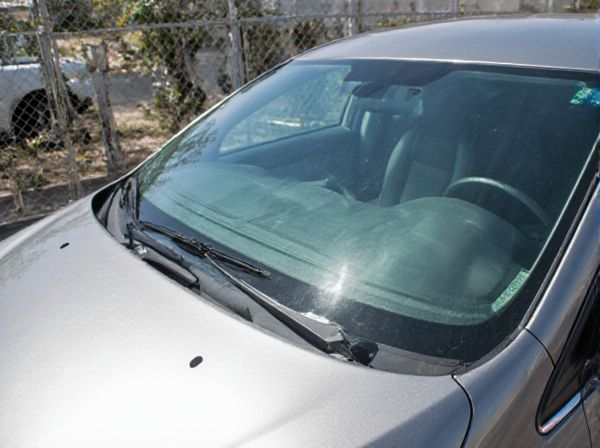
Photo illustration: Laminated vs Tempered Windshield
Laminated windshields consist of two layers of glass with a plastic interlayer, providing enhanced safety by holding shards together during impact, reducing the risk of injury. Tempered windshields are heat-treated to increase strength but shatter into small, blunt pieces upon breakage, minimizing sharp edges. Your choice depends on the type of vehicle and safety requirements, with laminated glass commonly used for windshields due to its durability and impact resistance.
Table of Comparison
| Feature | Laminated Windshield | Tempered Windshield |
|---|---|---|
| Composition | Two glass layers bonded with a polyvinyl butyral (PVB) interlayer | Single glass layer heat-treated for strength |
| Safety | Holds shards together upon impact, reducing injury risk | Shatters into blunt pieces, reducing deep cuts |
| Use in Vehicles | Commonly used for front windshields | Typically used for side and rear windows |
| Impact Resistance | Higher resistance due to layered structure | Strong but can break under sharp impact |
| Noise Reduction | Better sound insulation | Less effective at noise reduction |
| UV Protection | Better ultraviolet ray blocking | Limited UV protection |
| Repairability | Easier to repair minor chips and cracks | Often requires full replacement after damage |
| Cost | Higher cost due to complex construction | Lower cost compared to laminated glass |
Introduction to Windshield Types
Laminated windshields consist of two glass layers bonded with a plastic interlayer, offering enhanced safety by preventing glass shattering upon impact. Tempered windshields are made from heat-treated glass, designed to break into small, blunt pieces to reduce injury risk. Understanding these primary windshield types is crucial for selecting the right option based on safety, durability, and vehicle compatibility.
What is a Laminated Windshield?
A laminated windshield consists of two layers of glass bonded together with a durable plastic interlayer, typically polyvinyl butyral (PVB), which enhances safety by preventing shattering upon impact. This construction provides superior noise reduction, UV protection, and resistance to penetration from debris, making it the most common type used in vehicles. The laminated design also maintains structural integrity, helping to support the roof and prevent occupant ejection during accidents.
What is a Tempered Windshield?
A tempered windshield is made from annealed glass that undergoes a rapid heating and cooling process to increase its strength and safety properties. It shatters into small, blunt pieces upon impact, reducing the risk of severe injury during accidents. Commonly used in side and rear vehicle windows, tempered glass offers excellent resistance to impact and thermal stress.
Key Differences Between Laminated and Tempered Glass
Laminated glass consists of two or more layers of glass bonded with an interlayer, offering superior safety by holding shards together upon impact, while tempered glass is heat-treated to increase strength and shatters into small, blunt pieces upon breaking. Laminated windshields provide better sound insulation and UV protection due to the interlayer, whereas tempered glass is commonly used for side and rear car windows due to its rigidity and cost-effectiveness. The key difference lies in laminated glass's ability to maintain structural integrity after damage, enhancing occupant safety, whereas tempered glass prioritizes strength and breakage patterns for easier replacement.
Safety Features: Laminated vs Tempered Windshields
Laminated windshields consist of two glass layers bonded with a plastic interlayer that prevents shattering, significantly enhancing occupant protection during collisions by maintaining structural integrity and minimizing injury from glass shards. Tempered glass, used in side and rear windows, is designed to break into small, blunt pieces, reducing the risk of severe cuts but offering less resistance to penetration compared to laminated glass. The superior safety performance of laminated windshields makes them the preferred choice for frontal impact protection in modern vehicles.
Durability and Impact Resistance Comparison
Tempered windshields offer high impact resistance by shattering into small, less harmful pieces upon severe impact, enhancing safety but compromising full structural durability. Laminated windshields consist of two glass layers bonded by a plastic interlayer, which maintains glass integrity during impact, providing superior durability and preventing shards from dispersing. This design makes laminated windshields more effective in preserving visibility and vehicle structure while resisting penetration and damage.
Repairability and Replacement Considerations
Laminated windshields consist of two layers of glass with a plastic interlayer, allowing minor cracks to be repaired without full replacement, which reduces repair costs. Tempered windshields, made from heat-treated glass, shatter into small pieces upon impact, making repair impossible and necessitating complete replacement. Vehicle safety, cost efficiency, and insurance coverage often favor laminated windshields for ease of repair and longevity.
Cost Differences: Laminated Versus Tempered
Laminated windshields generally cost more than tempered glass due to their complex manufacturing process, which involves bonding multiple layers for enhanced safety and durability. Tempered windshields are usually less expensive but offer lower impact resistance and shatter into small pieces upon breakage. The price difference reflects the superior safety features and longer lifespan associated with laminated windshields compared to the more affordable yet less resilient tempered glass.
Legal Requirements and Industry Standards
Laminated windshields meet strict legal requirements as they are designed with a PVB interlayer that holds glass fragments together upon impact, ensuring passenger safety and compliance with FMVSS 205 in the U.S. Tempered windshields, while stronger against impact, shatter into small granules and typically do not meet safety standards for front windshields in most jurisdictions due to higher injury risk. Industry standards universally mandate laminated glass for vehicle windshields to provide durability, shatter resistance, and occupant protection, reinforcing regulatory frameworks across global automotive safety regulations.
Which Windshield Type is Best for You?
Choosing between laminated and tempered windshields depends on safety priorities and vehicle use. Laminated windshields, made with a plastic layer between glass sheets, offer superior impact resistance and prevent shattering, ideal for front windshields in passenger cars. Tempered windshields, which break into small, less dangerous pieces, are commonly used in side and rear windows, providing better visibility but less protection against impacts.
 caratoz.com
caratoz.com